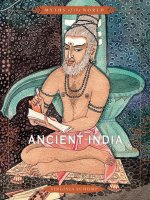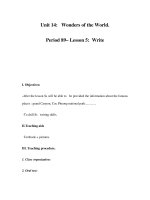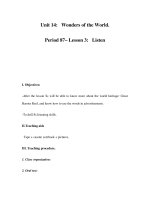sacred places of the world
Bạn đang xem bản rút gọn của tài liệu. Xem và tải ngay bản đầy đủ của tài liệu tại đây (20.65 MB, 209 trang )
SACRED
PLACES
r ~.
T~E
,
ORLD
A
Religious
Journey
Across
the
Globe
Edited
and
Compiled
by:
~
Robert H. Dalton
ABHISHEK
All rights reserved. No part
of
this book may be reproduced
in
any
form, electronically
or
otherwise, in print, photoprint, micro film
or
by
any other means without written permission from the publisher.
ISBN
Copyright
Revised Edition
Published by
Publisher
2010
ABHISHEK PUBLICATIONS,
S.C.O. 57-59, Sector 17-C,
CHANDIGARH-1600
17
(India)
Ph 2707562,Fax-OI72-2704668
Email:
978-81-8247-363-8
PREfACE
The
whole universe
is
a beautiful creation
of
God. Still some
places are more scenic and sacred than the others. These places
have given and are still giving its visitors peace and relief from
the pestering burden
of
daily
life.
Since time immemorial people
useg
to
travel a lot
to
pay their homage
to
their respective
religious places
or
their revered saints' tomb. Moreover, these
places are
known
for
the
mental and spiritual tranquillity they
provide for an all-round betterment
of
their visitors.
In
earlier
days, people
undertook
a lot
of
toil
to
make a journey success-
ful.
Horse
riding
or
camel riding was the only available
mod~
of
conveyance. There always remained a lot
of
risk during a
lorig
and
tiresome journey.
Now
days
it
has become a lot
easier due the availability
of
more and
more
economic and
developed conveyances.
The
only thing required
is
proper
in-
formation and guidance
about
the desired destination.
In
this splendid little creation we have endeavoured
our
best
to
provide the reader
with
almost all the available knowledge
and
information
about
a huge
number
of
sacred places cover-
ing
almost all the religions that are spread
throughout
the
world. With a very first
hand
experience we have compiled the
data
in
a well-organised
way.
Readers will find
it
very handy
as
a reference book.
It
contains the sacred place
of
almost
all
the
prominent religions; viz. Christianity, Islam, Buddhism,
Hin-
duism, Judaism etc.
It
is
a concise yet exhaustive reference
to
the
most
holy places
of
the world. Pictures
of
almost
all
the
places has been provided so that
you
not
only read about them
but
also see
them
and
imagine the beauty
of
the
places.
CONTENTS
1.
Bethlehem - Birth Place
of
Jesus Christ 7
2. The Church
of
the Nativity 9
3.
Capernawn, The City
of
Jesus
11
4.
Vatican City
13
5.
Mount Fuji
15
6. Golden Temple - Amritsar 17
7.
The Sacred Mount Agung,
Bali
19
8.
Bagan, Burma
21
9.
Mandalay, Burma 24
10.
Sacred Place for Bahai
~
26
11.
Haridwar, India
28
12. Banaras, India
30
13. Pushkar, India 32
14. Allahabad,
U.P.
34
15.
Shiva Temples
of
Rameshvaram and Badrinath 36
16. The
Shrine
of
the Bab, Bahai
38
17. Bodh Gaya, India 40
18.
Shatrunajaya, India 42
19. Miyajima Island, Japan
44
20. Haguro San, Japan 46
21. Djenne, Mali 48
22. Bukhara, Uzbekistan
50
23. Monasteries
of
Tashilhunpo and Toling, Tibet 52
24. Jokhang Temple, Lhasa, Tibet
54
25. The Potala
Palace,
Tibet 56
26. Mt. Kailash, Tibet 58
27. That
Phanom, Thailand 60
28. Neolithic Temples
of
Malta 62
29. Kairouan, Tunisia
64
30. Touba, Senegal 66
31. Nuestra
Senora de Guadalupe, Mexico City 68
32. Mitla, Mexico
70
II
SacredPJacesofthe World
511
33. Cheju-Do, Korea 72
34. Monte Alban, Mexico
74
35. Swayambhunath Stupa, Kathmandu, Nepal 76
36. Monastery
of
Izamal, Yucatan, Mexico 78
37. Adam's
Peak, Sri Lanka 80
38. Mihintale Buddha, Sri Lanka 82
39. Uxmal, Yucatan, Mexico
84
40 Chichen Itza, Yucatan, Mexico 86
41. Mecca, Saudi Arabia
88
42. Pilgrimage and Sacred sites in Shi'ite Iran 91
43. Devil's Tower,
USA 93
44
. Mashhad, Iran
95
45. Shiraz, Iran
.
97
46. Chaco Canyon, New Mexico
99
47. Zoroastrian Sacred Sites 101
48.
Pir-e-Sabz shrine 103
49.
Avila,
Spain
.
105
50.
Zaragoza, Spain 107
51. Takht-e Suleiman, Iran
.
109
52. Assisi, Italy
111
53. Temple
of
Hera, Paestum, Italy 113
54. Einsiedeln, Switzerland 115
55. Externsteine, Germany 117
56.
Petra, Jordan 119
57. Jebel Musa, Jordan
121
58. The Abbey
of
Conque, France 123
59.
Petra, Jordan 125
60. Durham and
York
Cathedrals, England 127
61. Baalbek, Lebanon 129
62. Canterbury Cathedral, England 131
63. Mt. Ararat, Turkey 133
64. Bath, England 135
65. Bornholm, Denmark 137
66. Black Hills,
USA 139
116
Saaed
Places
of
the World
II
67. Sarnath, India 141
68. J agannath Temple 143
69. R.ameswaram 145
70. Shrine
of
Mata Vaishno Devi 147
71.
Ayers
Rock, Uluru, England 149
72. Basilique
du
Sacre Coeur, France 151
73. Baptistery
of
San Giovanni 153
\
74. Blue Mosque, Istanbul 155
75.
Ayasofya
(Hagia Sophia) 157
76.
Santa Maria della Salute
159
77. The Basilica
of
Santa Maria Sopra Minerva 161
78. Mt. Athos, Greece 163
79. The
Shrine at Czestochowa, Poland 165
80. Langalband 167
81.
Axum, Ethiopia 169
82. Puttaparthi, India
171
83. Deshnok - Mata
Karni, India 173
84.
Sri Venkateswara Temple, India 175
85. Mathura
177
86.
Shirdi, India 179
87. Sabrimala,
Kerala, India 181
88. Palitana, Gujarat, India 183
89. KaIadi 185
90. Mount Taishan
(Tai
Shan), China
187
91.
St.
Michael's Mount, Cornwall, England 189
92. Chalma 191
93.
Atotoniico, Mexico 193
94. Monte Alban, Mexico 195
95. Knock
Shrine
197
96. Gurdwara BangIa
Sahib
Ji,
India
199
97. Meteora Monasteries
201
98. Delwara Temples, Rajasthan, India 203
99. Konya, Turkey 205
100.
Gurdwara Rakabganj Sahib Ii, India 207
1
BETItlEitEM
BiRTIt
PlACE
of
JESUS
CItRisT
Bethlehem
is
the birthplace
of
Jesus and therefore a holy site to
Christians around the world. The church
is
built over a grotto
where the Virgin
Mary
is
said to have given birth to Jesus. The
city also
is
significant to
Jews
because it
is
the burial place
of
the
matriarch Rachel and the birthplace
of
King David. Samuel
anointed David king in Bethlehem (I
Sam. 16:1-13) and David
was a descendant
of
Ruth
and Boaz, who were married in
Bethlehem. The
city,
just 5 miles south
of
Jerusalem,
was
turned
over to the Palestinian Authority
as
a result
of
the 1995 Israeli-
Palestinian Interim Agreement.
The church's large fortress-like exterior stands
as
a testament to
its turbulent
history.
For centuries, it
was
one
of
the most fought
over holy places.
It
was
seized and defended by a succession
of
118
SacredPlacesofthe World
II
armies - including Muslim and Crusader forces. The entrance to
the church
is
a low doorway that has its own legends. One story
is
that the door was installed'
by
the Muslims during their rule to
remind Christians that they were guests in the country and must
bow to their hosts.
An
alternative explanation
is
that the height
of
the door was designed to prevent unbelievers from entering the
church
on
horseback.
Yet
another version holds
that)t
was
to pro-
tect the Christians from their hostile neighbours.
Bethlehem has a population
of
approximately 50,000 people, with
the Muslims holding a slight majority.
In
Hebrew, the town
is
Bet
Lehem ('House
of
Bread') and, in Arabic,
it
is
Bet Lahm ('House
ofMeat'). For centuries, Christian pilgrims have made the roughly
21/2
hour walk from Jerusalem to Manger Square.
Today,
the trip
typically begins at the train station in Abu Tor and proceeds along
the
Hebron
Road.
It
is
controlled jointly by three Christian denominations - the
Ar-
menian Church, the Roman Catholic Church and the Greek Or-
thodox Church.
•
The Grotto
of
the Nativity contains the manger that
is
be-
lieved to be the place where the baby Jesus was laid after he was
born. The grotto
is
encased in white marble.
,
• The site
of
the birth
is
marked by a 14-point star
on
a marble
stone.
• The
High
Altar standing above the Grotto.
The site has been venerated by Christians since
St Justin Martyr
identified
it
as
the site
of
Jesus' birth in the second century.
Manger
Square
is
the focus
of
activity
of
Christmas celebrations
not
once,
but
three times a
year.
In
addition to the traditional
Western celebration which begins
on
December 24, the Greek
Orthodox mark their Christmas
on
January 6 and the Armenian
observance
is
on
January 19.
2
TItE
CItURCIt
of
TItE
NATiviTY
The Church
of
the Nativity was built
in
the
4th
century by the
mother
of
the Byzantine Emperor Constantine. Helena also was
the person responsible for the construction
of
the Church
of
the
Holy
Sepulchre in Jerusalem. The present building, the oldest
church in Israel/palestine was reconstructed
in
the
6th
century by
the Emperor Justinian (527-565) and further repaired by the Cru-
saders. The church has a colourful history When the Persians in-
vaded in 614, they left the church intact, legend has
jt, because
they were moved by a painting inside
of
tile Nativity story depict-
ing the
Wise
Men
of
the East in Persian clothes. King Edward IV
of
England donated wood from English oak trees for the ceiling.
He
also contributed lead
to
cover the roof, but that was taken by
the Turks, who melted it down to use
as
ammunition in their war
against the Venetians.
The entrance to the church
is
a low doorway that has its
own
legends. One story
is
that the Muslims installed the door during
IpO
&credHacerofthe
World"
their rule to remind Christians that they were guests in the coun-
try and must bow
to
their.,hosts. An alternative explanation
is
that
the height
of
the door was designed to prevent unbelievers from
entering the church
on
horseback.
Yet
another version holds that
it was to protect the Christians from their hostile neighbours.
The church
is
divided into
five
naves by four rows
of
Corinthian
pillars with pictures
of
the apostles
on
them. The names are writ-
ten in Greek and Latin and many visitors have carved their
own
signatures over the centuries. The floor
of
the nave has a hole that
allows you to see what remains
of
the Byzantine mosaics that
covered the original church floor.
The Altar
of
the Nativity sits below a silver
and
. gold chandelier.
Stairways
on
either side
of
the main altar lead
to
a grotto. A four-
teen-point silver star embedded in white marble indicates the
birthplace
of
Christ. An inscription reads, Hie
de
Vir;gine
Maria
Jesus Christus
natus
est (''Here Jesus Christ was born to the Virgin
Mary"). Fifteen lamps burn around the spot. Nearby
is
the Chapel
of
the Manger, where Mary placed the baby Jesus. Like the
Church
of
the
Holy
Sepulchre, various Christian denominations
share control over different parts
of
the church. The grotto
is
under the jurisdiction
of
the Greek Orthodox Church.
The traditional midnight mass celebrated
on
Christmas Eve
is
held in St. Catherine's, the Roman Catholic Church next door to
the
Church
of
the Nativity. This
is
also the site
of
several chapels
with their
own
historic and religious significance.
3
CAPERNAUM,
TltE
CiTY
of
JESUS
The city
of
Capernaum
was
built
on
the northern shore
of
the Sea
of
Galilee, about two miles west
of
the Jordan
River.
Though this
ancient town
is
not mentioned by name in the Old Testament, it
is
referred to
as
our Lord's 'own city' (Matt.
9:
1), for it became the
centre
of
His Galilean work and ministry Early in his account
of
the gospel, Matthew points
out
that Jesus began His Galilean
ministry here in order to fulfil
Old Testament prophecy: '1\nd leav-
ing
Nazareth,
He
came and dwelt in Capernaum, which
is
by the
sea, in the regions
of
Zebulw1 and Naphtali, that it might
be
ful-
filled which
was
spoken by Isaiah the prophet, saying: 'The
bnd
of
Zebulun and the land
of
Naphtali, the way
of
the sea, beyond
the Jordan, Galilee
of
the Gentiles: the people who sat in dark-
ness
saw a great light and upon
d10se
who sat in the region and
shadow
of
death light
has
dawned.'" (Matt.
4:
13-16).
1112
SacredPlacesofthe World
II
Prior
to
this ascension back into heaven, Jesus gave the Great
Commission after "eleven disciples went away into Galilee, to the
mountain which Jesus had appointed for
them" (Matt. 28:16).
Five men from Capernaum (Peter, Andrew, James, John and
Matthew) were called by the Lord to be His apostles. Jesus had
often stayed in Peter's house in Capernaum and preached in the
synagogue there which had been built by a Roman centurion (Luke
7:5). The city was important enough to have a tax office, over
which Matthew had presided (Matt. 9:9). A detachment
of
Ro-
man soldiers was stationed in the town.
The kingdom
of
God encompassed a realm that extended well
beyond the borders
of
ancient Israel. Jesus demonstrated His
power to heal, for
"in the synagogue there was a man who had a
spirit
of
an unclean demon." Jesus rebuked the demon and he
came
out
of
the man "and did
not
hurt him." Witnesses
of
the
miracle
"were all amazed and spoke among themselves, saying,
'What a word
this is! For with authority and power
He
commands
the unclean spirits, and they come out.' (Luke 4:31-36).
As
a re-
sult
of
this miracle a "report about
Him
went
out
into every place
in the surrounding
region" (Luke 4:37).
It
was at Capernaum
that Jesus paid the temple tax by having
Peter "go to the sea, cast
in a hook, and take the fish that comes up first. And when you
have opened its mouth, you will fmd a piece
of
money; take that
and give
it
to them for Me and you." (Matt. 17:27).
4
VATicAN
CiTy
Vatican
City,
independent state,
under
the absolute authority
of
-the pope
of
the Roman Catholic Church.
It
is
an enclave within
Rome, Italy, with an area
of
44
hectares (110 acres). The smallest
independent country in the world, Vatican
City was established in
1929 under terms
of
the Lateran Treaty, concluded by the Italian
government and the papacy after many years
of
controversy. This
treaty was superseded in 1984 by a new concordat, which, like its
predecessor, recognised the full sovereignty
of
the Holy See (the
jurisdiction
of
the pope) within the state
of
Vatican
City.
Vatican City
is
situated
on
Vatican Hill in northwestern Rome,
just west
of
the Tiber River.
It
is
surrounded by medieval and
Renaissance walls and
has
six
gates. Many
of
the most renowned
artists and architects
of
the Italian Renaissance were commis-
sioned by popes to work
on
the Vatican's buildings. The most
1114
Sacred
Places
of
the
World
II
imposing and important edifice
is
Saint Peter's
Basilica.
Built for
the most part between the 15th and 17th centuries and designed
by
artists, including Bramante, Michelangelo, and Gianlorenzo
Bernini, it
is
the world centre
of
Roman Catholic worship.
In
front
of
the Basilica
is
the great Piazza San Pietro (Saint Peter's
Square). The other major edifice
is
the
Palace
of
the Vatican, also
known
as
the Papal
Palace
.
It
is
a complex
of
buildings that con-
tains more than
1,000 rooms and
hO'lses
the papal apartments,
the government offices
of
the Roman Catholic Church, several
chapels and museums and a library. The most famous portions
of
the palace are the Sistine Chapel, with its great ceiling frescoes
painted by Michelangelo (restored
1980-1990); and Raphael's
Rooms, papal apartments with frescoes painted by the Italian
art-
ist Raphael.
The pope, who has absolute executive, legislative and judicial pow-
ers, governs Vatican
City.
The executive powers are delegated to
a governor, who
is
responsible directly to the pope.
In
the
exer-
cise
of
his legislative powers, the pope
is
advised and assisted by
the
Sacred College
of
Cardinals and by the various Sacred Con-
gregations. The judicial powers are exercised by tribunals; ap-
peals from their decisions are heard by the sacred Roman Rota
and by the
Supreme Tribunal
of
the Apostolic Signature. The
Sec-
retariat
of
State represents the Holy
See
in diplomatic relations
with foreign powers.
Swiss Guards maintain internal security and
protection
of
the pope; the Piazza San Pietro
is
subject to the
authority
of
the Italian police. Castel Gandolfo, the papal sum-
mer palace outside Rome,
as
well
as
other buildings located in
Rome but outside
of
Vatican
City,
are endowed with extraterrito-
riality.
5
MOUNT
Fuji
•
Japan
is
one
of
the world's most mountainous countries, so it's
not
surprising that mountain worship
is
an historic element
of
Japanese culurre. And
of
all the mow1tains in Japan, Mount Fuji
stands
out
as
a unique culnrral symbol. At 12,388 feet, Fuji
is
Japan's tallest mountain. It's easily recognised and greatly admired
for its perfect volcanic-cone shape, which
is
like an inverted
fan.
Japan's two major religions, Shinto and Buddhism, regard Fuji
as
sacred and Japanese from all walks
of
life attest to the power
of
tl1is
natural symbol so deeply inscribed in the national psyche.
Unlike many other sacred mountains, belief dictates that this one
should be climbed and hundreds
of
thousands
of
people, both
religious adherents and tourists, climb Fuji
every year. This popu-
larity
has
caused a pollution problem so severe that it has pre-
vented
Mount
Fuji from receiving designation
as
a
UNESCO
11
16
SacredPlacesofthe World
II
World Heritage site.
Mount
Fuji
is
a composite volcano, growing larger
as
layer
upon
layer
of
lava and ash built
up
on
its slopes. Like its geologic
his-
tory,
Mount
Fuji's sacred history has also developed over time
as
different religions, beliefs and myths have added new layers. Since
ancient times, the mountains
of
Japan have been revered
as
sa-
cred places, giving rise to a tradition
of
beliefs and rituals that
scholars call sangaku shinko, meaning 'mountain creed'. When
Shimo, the native religion
of
Japan, emerged sometime before
the sixth century A.D., it wove this mountain creed into a wider
veneration
of
nature. According to Shinto belief, natural features
such
as
trees, lakes, streams, rocks and mountains are the
dwell~
ing places
of
spirits called karni, which hold influence over human
affairs and respond to
human
prayer
and
ritual. Kami are be-
lieved
to
be concentrated
in
mountain areas and shrines have been
erected.to mark sacred spots.
The
name 'Fuji' most likely came from
an
indigenous Ainu
word
meaning 'deity
of
fire'
-not
was surprising for a volcano
that
erupted often.
In
about
800
.A.D., a shrine was built near the base
of
the mountain with the hope
of
placating the
god
that caused
the volcano's eruptions. Fuji later became regarded
as
the dwell-
ing
of
the Shinto goddess Konohana Sakuya Hime, 'the Goddess
of
the Flowering Trees'. Today, she
is
still the principal deity
of
the
sacred mountain, revered in
Shinto shrines at Fuji's base and sum-
mit, including the one originally built for the older fire
god and
honoured
in
a fire ceremony at the end
of
each year's climbing
season.
Today, pilgrims, including members
of
Fuji-ko, still climb
Mount
Fuji. Some stop to worship at the shrine
of
Konohana Sakuya
Hime, pray at the swnrnit altars
or
ritually circumambulate the
volcano's crater.
6
GoLdEN
TEMpLE
'
AMRiTSAR
It
is
a place
of
both stupendous beauty and sublime peacefulness.
Originally a small
lake
in the midst
of
a quiet forest, the site has
been a meditation retreat for wandering mendicants and sages
since deep antiquity. The Buddha
is
known to have spent time at
this place · in contemplation.
Two
thousand
years
after Buddha's
time, another philosopher-saint came to
live
and meditate by the
peaceful
lake.
This
was
Guru Nanak (1469-1539), the founder
of
the Sikh religion.
Mtcr
the passing away
of
Guru Nanak, his dis-
ciples continued to frequcnt
dle site; over the centuries it became
dle primary sacred shrine
of
the Sikhs. The
lake
was enlarged and
structurally contained during the leadership
of
the fourth Sikh
Guru (Ram Dass, 1574-1581) and during the leadership
of
the
fifth Guru (Arjan, 1581-1606), the Hari Mandir,
or
Temple
of
God was built. From the early 1600s to the mid 1700s the sixth
through tenth
Sikh Gurus were constandy involved in defending
1118
SaCJ"edP/acesofthe World
II
both their religion and their temple against Moslem armies.
On
numerous occasions the temple was destroyed by the Moslems
and each time was rebuilt more beautifully by the Sikhs. From
1767 onwards, the
Sikhs became strong enough militarily to re-
pulse invaders.
Peace returned
to
the
Hari
Mandir.The temple's
architecture draws
on
both
Hindu
and Moslem artistic styles yet
represent a unique co-evolution
of
the two. During the reign
of
Maharaja Ranjit Singh (1780-1839), Hari Mandir was richly or-
namented with marble sculptures, golden gilding and large quan-
tities
of
precious stones. Widun the sanctuary,
on
a jewel-studded
platform, lies the
Adi
Grantha, the sacred scripture
of
the Sikhs.
This scripture
is
a collection
of
devotional poems, prayers and
hymns composed by the ten
Sikh
gurus
and various Moslem and
Hindu
saints. Beginning early in the morning and lasting until
long past sunset, these hymns are chanted
to
the exquisite accom-
paniment
of
flutes,
drums
and stringed instruments. Echoing across
the serene lake, this enchantingly beautiful music induces a deli-
cate yet powerful state
of
trance
in
the pilgrims strolling leisurely
around the marble concourse encircling the
pool
and temple.
An
underground spring feeds the sacred lake
and
throughout the day
and night pilgrims immerse themselves
in
the water, a symbolic
cleansing
of
the soul rather than an actual bathing
of
the body.
Amritsar means
'pool
of
ambrosial nectar'. Looking deeply into
the origins
of
dns
word
amrit, we fmd that
it
indicates a drink
of
the gods, a rare and magical substance that catalyses euphoric
states
of
consciousness and spiritual enlightenment. With this
word we have a very clear example
of
the spirit, power,
or
ener-
getic character
of
a particular place becoming encoded
as
an an-
cient geograplncal place name.
7
litE
SACREd
MOUNT
AGUNG,
BALi
This sacred mountain
is
to the Balinese what Olympus
was
to the
ancient Greeks-the Cosmic Mountain. The Balinese, who con-
sider this volcano 'the Navel
of
the World', always sleep with their
heads toward Agung. The mystical Balinese believe the gods raised
the mountain
as
advantage point to view the unceasing pageant
of
life below. To them,
it
is
a central, heavenly point
of
reference, the
geographical and religious centre
of
the world. With an elevation
of
3,014 meters, the foot
of
the mountain stretches northeast right
to the
sea.
To
the southeast its slope
is
blocked by a line
of
small
extinct volcanoes; to the northwest Agung
is
separated from
Gunung Batur by a narrow
valley.
The gods rest above the mountain summit and when they come
down to visit the island they reside in
Bali
's holiest temple com-
plex, Besakih, six
km
below the crater. When the gods
are
dis-
pleased, Agung showers the land with stone and ruin. Its feathery
heights are the source
of
life-giving rivers and volcanic ash, which
irrigate and enrich the island's
rice
fields. The lower portions
of
the mountain are heavily forested and faimed up to about 1,000
meters.
History
of
Gunung Agung
A major eruption in
1350 so fertilised the land around Besakih
that year after year it
has
yielded enough
rice
to not only supply
1120
SacredPlacesofthe World
II
the needs
of
the complex
but
also defray the costs
of
the wlending
ceremonies staged in dle
mOWltain's honour. Agung's most
re-
cent eruption occurred in the closing
years
of
the turbulent Sukarno
regime, in 1963. The cataclysm began during the greatest
of
Ba-
linese ceremonies, Eka Dasa Rudra, an exorcism
of
evil staged
only once every
100 years. Except for minor activity in 1808 and
1843, this
was
dle first time the sacred volcano had blown since
1350.
Many
people looked upon the disaster
as
a divine condemnation
of
the ill-fated Sukarno regime, and the subsequent failure
of
crops, uprooting
of
villages, and forced evacuation
of
86,000 people
contributed substantially to the commWlal clashes and massacres
during the so-called purge
of
Indonesian 'communists' in 1966.
Because empty land for the evacuees
was
no longer available
on
Bali, the consequences
of
overpopulation became acute for the
first time in the island's history.
No
longer could farmers move
temporarily to another part
of
the island, later returning to a land
covered in fresh, fertile ash. Thousands were instead resettled in
transmigration camps in central
Sulawesi.
Few scars remain today. Until well into the 1970s lava streams
blackened the coWltryside northeast
of
KlWlgkWlg,
but
the re-
gion
is
now replanted with fields and gardens.
8
BAGAN,
BURMA
There are
two
pre-eminent ancient religious cities
in
South-
east Asia: Bagan in Burma and Angkor in Cambodia.
Both
sites are notable for their expanse
of
sacred geography and the
number and size
of
their individual temples. For many visitors
Bagan
is
the more extraordinary
of
the two cities and this be-
cause
of
the view. The ruins
of
the more than one hundred
Angkor temples stand alone and isolated
in
thick jungles and
only from the
top
of
the tallest temples it
is
not
possible
to
see
others in the distance. Sprawling across a vast dusty plain, the
ruins
of
Bagan are unhidden. There being no trees to obstruct
the
view, one may gaze over forty square miles
of
countryside,
upon
literally thousands
of
temples.
In
the early morning, from
1122
SaaedPlacesofthe World
II
Sulamani Temple,
or
in the late afternoon, from Gawdawpalin
Temple, the view
is
among the very finest the world has to
offer.
While the kingdoms
of
Bagan date back to the early 2nd cen-
tury A.D., Bagan only entered its golden age with the con-
quest
of
Thaton by King Anawrahta in
1057
A.D. From this
time, until Kublai Khan's forces overran Bagan in 1287 A.D.,
more than
13,000 temples, pagodas and other religious struc-
tures were built. Today, seven
centuries later, approximately
2,200
temples remain standing.
The
river Ayeyirwady has
washed away nearly one-third
of
the original city area, thieves
have
torn
apart many temples in search
of
treasures, while
earthquakes and the ravages
of
time have reduced hundreds
of
others to great piles
of
crumbled stones.
The
photographs
il-
lustrate the following temples:
Ananda Temple
King Kyanzittha completed this temple in
1091 A.D.
It
is
mod-
elled after the legendary Nandamula cave
in
the Himalaya
Mountains. Soaring to 51 meters, it received its golden gild-
ing in
1990 in commemoration
of
the
900th
anniversary
of
its
construction. Contained within the temple are four great stat-
ues
of
the Buddhas
of
the four ages. Kakusandha
faces
north,
Konagamana faces east, Kassapa faces
south
and Guatama,
the most recent Buddha,
faces
west.
II
Bag;m,
Bunn.1
Dhammayangyi
The largest temple in Bagan, it
was
built by King Narathu who
reigned from 1167 to
1170.
Shwezigon ,
This pagoda was built
as
the most important reliquary shrine in
Bagan. Begun by King Anawrahta and completed by King
Kyanzittha in 1089, it contains several bones and hairs
of
the Bud-
dha. Pilgrims from throughout Burma journey to Shwezigon each
year for a great festival during the Burmese month
of
Nadaw,
which
falls
in the November-December period. This festival
is
hugely popular because elements
of
pre-Buddhist Nat worship
(Nats are pagan animistic spirits) were combined with Buddhist
themes in the pagoda's construction.
9
M~NdALAy,
BURMA
Legends tell that Gautam Buddha once went to teach among the
people ofDhannavati (now the
northern Rakhine region
of
Burma/
Myanmar). The king, Candra-suriya, requested that Gautam leave
an image
of
himself for the benefit
of
the people. Buddha sat for
a week
of
meditation urider a Bodhi tree while Sakka, a king
of
the gods, created a life-like image
of
great beauty. Buddha was
pleased with
the image and decided to imbue it with
his
spiritual
, essence for a period
of
five
thousand years.
According to ancient tradition, only
five
likenesses
of
the Buddha
were said to have been made during his lifetime: Two were in
India, two in paradise and the fifth
is
the Maha Muni
or
'Great
Sage'. Archaeologists believe the image was probably cast during
the reign
of
King Chandra Surya, who ascended the throne in AD
146, some
600
years after the Buddha actually passed
away.
Little
is
known
of
the Maha Muni's travels over the next fifteen hun-









